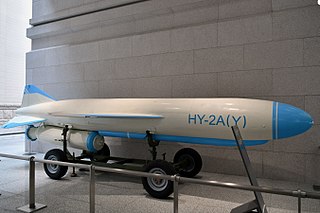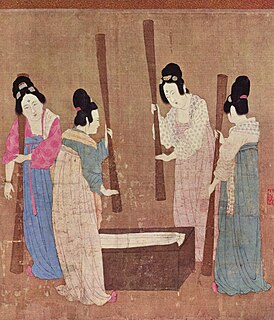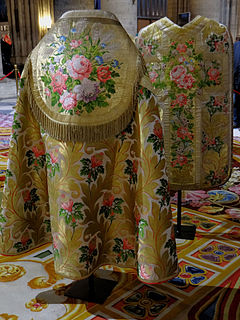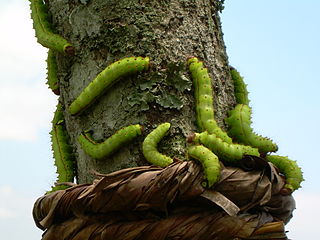
Silk is a natural protein fiber, some forms of which can be woven into textiles. The protein fiber of silk is composed mainly of fibroin and is produced by certain insect larvae to form cocoons. The best-known silk is obtained from the cocoons of the larvae of the mulberry silkworm Bombyx mori reared in captivity (sericulture). The shimmering appearance of silk is due to the triangular prism-like structure of the silk fibre, which allows silk cloth to refract incoming light at different angles, thus producing different colors.

Bombyx mori, the domestic silk moth, is an insect from the moth family Bombycidae. It is the closest relative of Bombyx mandarina, the wild silk moth. The silkworm is the larva or caterpillar of a silk moth. It is an economically important insect, being a primary producer of silk. A silkworm's preferred food are white mulberry leaves, though they may eat other mulberry species and even the osage orange. Domestic silk moths are closely dependent on humans for reproduction, as a result of millennia of selective breeding. Wild silk moths are different from their domestic cousins as they have not been selectively bred; they are thus not as commercially viable in the production of silk.

The Shang You or SY-series, and the Hai Ying or HY-series were early Chinese anti-ship cruise missiles. They were derived from the Soviet P-15 Termit missile.
In Greek mythology the Styx is the river that forms the boundary between the underworld and the world of the living, as well as a goddess; and a nymph that represents the river.

Sericulture, or silk farming, is the cultivation of silkworms to produce silk. Although there are several commercial species of silkworms, Bombyx mori is the most widely used and intensively studied silkworm. Silk was believed to have first been produced in China as early as the Neolithic Period. Sericulture has become an important cottage industry in countries such as Brazil, China, France, India, Italy, Japan, Korea, and Russia. Today, China and India are the two main producers, with more than 60% of the world's annual production.
Brocade is an American technology company specializing in storage networking products, now a subsidiary of Broadcom Inc. The company is known for its Fibre Channel storage networking products and technology. Prior to the acquisition, the company expanded into adjacent markets including a wide range of IP/Ethernet hardware and software products. Offerings included routers and network switches for data center, campus and carrier environments, IP storage network fabrics; Network Functions Virtualization (NFV) and software-defined networking (SDN) markets such as a commercial edition of the OpenDaylight Project controller; and network management software that spans physical and virtual devices.

A Banarasi sari is a sari made in Varanasi, an ancient city which is also called Benares (Banaras). The saris are among the finest saris in India and are known for their gold and silver brocade or zari, fine silk and opulent embroidery. The saris are made of finely woven silk and are decorated with intricate design, and, because of these engravings, are relatively heavy.

Sea silk is an extremely fine, rare, and valuable fabric that is made from the long silky filaments or byssus secreted by a gland in the foot of pen shells. The byssus is used by the clam to attach itself to the sea bed.

Silk in the Indian subcontinent is a luxury good. In India, about 97% of the raw mulberry silk is produced in the five Indian states of Karnataka, Andhra Pradesh, Tamil Nadu, West Bengal and Gujarat. Mysore and North Bangalore, the upcoming site of a US$20 million "Silk City", contribute to a majority of silk production. Another emerging silk producer is Tamil Nadu where mulberry cultivation is concentrated in Salem, Erode and Dharmapuri districts. Hyderabad, Andhra Pradesh and Gobichettipalayam, Tamil Nadu were the first locations to have automated silk reeling units.

Brocade is a class of richly decorative shuttle-woven fabrics, often made in colored silks and with or without gold and silver threads. The name, related to the same root as the word "broccoli", comes from Italian broccato meaning "embossed cloth", originally past participle of the verb broccare "to stud, set with nails", from brocco, "small nail", from Latin broccus, "projecting, pointed".

The production of silk originated in China in the Neolithic period. Silk production remained confined to China until the Silk Road opened at some point during the later half of the 1st millennium BC, though China maintained its virtual monopoly over silk production for another thousand years.

A caul is an historical headress worn by women that covers tied-up hair. A fancy caul could be made of satin, velvet, fine silk or brocade, although a simple caul would commonly be made of white linen or cotton. The caul could be covered by a crespine or a hairnet to secure it from falling off.

Thai silk is produced from the cocoons of Thai silkworms. Thailand's silkworm farmers cultivate both types of the domesticated silkworms that produce commercial silk: Samia ricini, commonly known as the eri silkworm, which produces matte eri silk, and the Bombyx mori, producer of the better known, glossy mulberry silk. The latter is by far the larger silk producer of the two.

Lampas is a type of luxury fabric with a background weft typically in taffeta with supplementary wefts laid on top and forming a design, sometimes also with a "brocading weft". Lampas is typically woven in silk, and often has gold and silver thread enrichment.

Wild silks have been known and used in many countries from early times, although the scale of production is far smaller than that from cultivated silkworms. Silk cocoons and nests often resemble paper or cloth, and their use has arisen independently in many societies.

Eri silk comes from the caterpillar of Samia ricini, found in northeast India and some parts of China, Japan. It was imported to Thailand in 1974. The name "eri" is derived from the Assamese word "era", which means "castor", as the silkworm feeds on castor plants. Another type of eri silk is "Ailanthus silk moth", refers to the host plant, Borkesseu, Ailanthus excelsa, practiced in China. Eri silk is also known as endi or errandi in India. The woolly white silk is often referred to as the fabric of peace when it is processed without killing the silkworm. This process results in a silk called Ahimsa silk. Moths leave the cocoon and then the cocoons are harvested to be spun. The eri silkworm is the only completely domesticated silkworm other than Bombyx mori.

Tussar silk is produced from larvae of several species of silkworms belonging to the moth genus Antheraea, including A. assamensis, A. mylitta, A. paphia, A. pernyi, A. roylei and A. yamamai. These silkworms live in the wild forests in trees belonging to Terminalia species and Shorea robusta as well as other food plants like jamun and oak found in South Asia, eating the leaves of the trees they live on. Tussar silk is valued for its rich texture and natural deep gold colour, and varieties are produced in many countries, including China, India, Japan, and Sri Lanka.
Kraig Biocraft Laboratories, Inc. is an American biotechnology company headquartered in Ann Arbor, Michigan. It develops and manufactures recombinant spider silks and other high-performance polymers using spider silk gene sequences. Kraig Labs holds intellectual property on various spider silk technologies, including exclusive global license agreements with US universities for patented core technologies and has a proprietary production process for their recombinant spider silks. Its flagship fiber is Dragon Silk™ which has been demonstrated to be tougher than many fibers used in bullet proof vests. In the fall of 2019, the company’s wholly owned subsidiary Prodigy Textiles LLC established a 45,000 sq ft production facility in Vietnam for the production of spider silk.
Ra'ad is an Iranian designed and built subsonic anti-ship cruise missile. The missile is a reverse engineered and upgraded variant of China's Silkworm anti-ship missile. The missile was developed by the state-run Iran Aviation Industries Organization (IAIO). Iran reportedly began full production of the Ra’ad in January 2004 and went into service in 2007. The missile is equipped for ground and ship-launched platforms.













